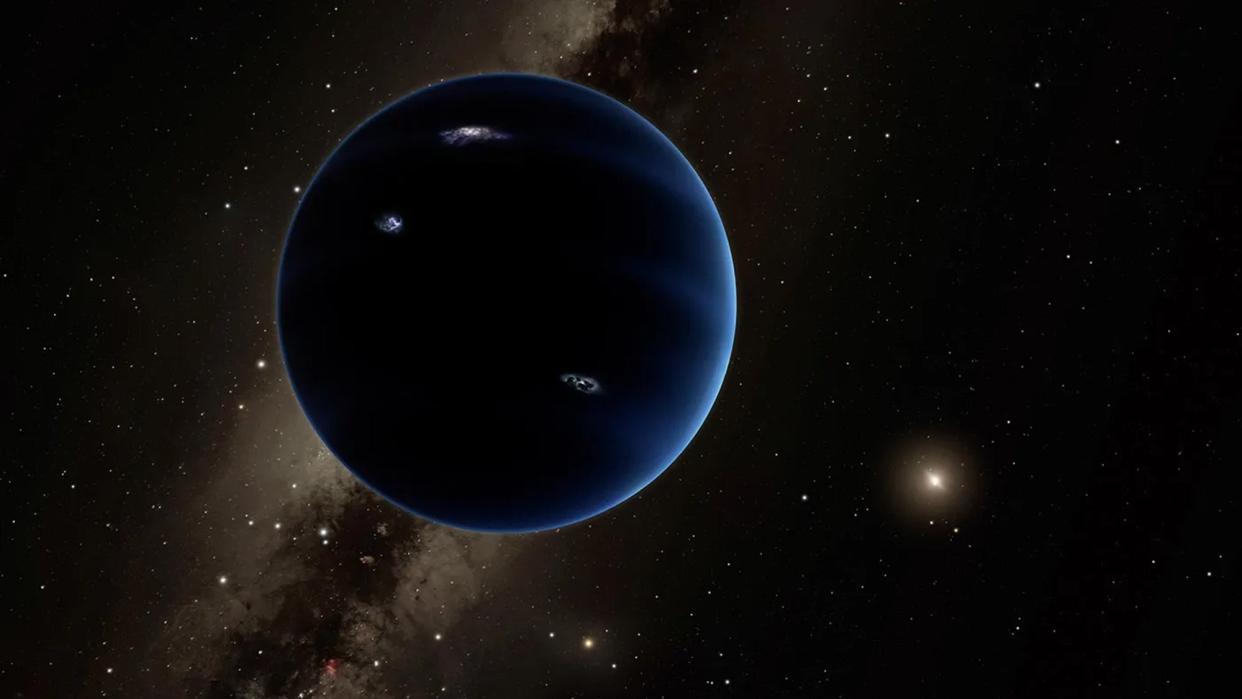Astronomers still haven’t decided if Planet 9 is real

Almost a decade after astronomers proposed the existence of Planet 9, an unseen extra planet in the distant reaches of the solar system, they still haven’t all agreed whether it’s real or not. Now, new research from Caltech astronomers just uncovered an extra line of evidence in favor of the hidden planet. Their computer simulations require Planet 9’s gravitational kick to explain how small bits of rock and ice from around Neptune’s orbit end up close to the sun.
“There is an open question of why particular objects in the solar system act the way they do, and we can’t quite explain it, but if you add Planet Nine into the model it all makes sense,” says Juliette Becker, an astronomer at the University of Wisconsin, Madison not affiliated with this new work.
These objects are Trans-Neptunian Objects (TNOs)--chunks of debris in the outer solar system, beyond Neptune and even Pluto. Until the 2000s, astronomers hadn’t spotted many TNOs—especially not the most distant ones. They’re incredibly faint, a result of their small sizes and huge distances from Earth and difficult to see. Once astronomers had built up a more substantial catalog of observed TNOs, however, they began to notice some strange trends.
A group of TNOs were bunched together, sharing similar orbits as if they were being wrangled up by something, like a group of sheep by a shepherd. These oddballs were orbiting at very high angles compared to other TNOs, and they were lined up in the same direction. Some astronomers, including the same Caltech crew behind the new bit of evidence, claimed that the most likely explanation for these observations was the existence of Planet 9 acting as a massive object acting as a gravitational shepherd for the TNO sheep.
However, other astronomers thought Planet 9 was an outlandish solution to the puzzle at hand, coming up with other ways to explain the unexpected observations. Some suggested that the clusters of TNOs could be a natural result of the solar system’s formation, with no need for Planet 9. Others thought that the shepherd was actually a small black hole instead of a giant planet. More recently, two astronomers in Japan proposed that a different planet, instead of Planet 9, might be lurking in the Kuiper Belt.
Theories abound for explaining the observed orbits of TNOs—and astronomers have spent the past eight years discussing and debating which make the most sense. This isn’t an anomaly, but instead an illustration of the scientific process. Scientists iteratively and collaboratively improve our understanding of a natural phenomenon, exploring all the evidence to find the best explanation for an observation.
Now, the Caltech team just showed how Planet 9 could be necessary to explain a different group of TNOs, which were somehow chucked towards the sun. An object on a path that crosses Neptune’s orbit, dips towards the sun, and swings back shouldn’t be able to stay that way for long. If we see objects in these kinds of orbits, something has to be pushing them to be there—perhaps even Planet 9.
“If Planet Nine exists, it would occasionally pull the orbits of distant Trans-Neptunian objects closer to the sun, to the point where they cross Neptune’s orbit. Without Planet Nine, these objects can't be pushed inward past Neptune very often,” explains Konstantin Batygin, Caltech astronomer and lead author on the new paper.
“Planet Nine would re-supply the population of these objects as they are depleted, explaining why we can see them at the present day when the Solar System is relatively old,” adds Becker
Throughout the years of theories, some astronomers have been entranced by the idea of actually spotting Planet 9 in the night sky. Despite the evidence of its gravitational influence, seeing is still believing and many of us won’t be satisfied until we have concrete proof that Planet 9 is there in our telescopes.
Batygin and co-author Mike Brown, also an astronomer at Caltech, have been hunting for Planet 9 using huge archives of data taken by surveys of the night sky from the Pan-STARRS1 facility atop Haleakala in Hawai’i, the Dark Energy Survey completed in Chile, and the Zwicky Transient Facility in nearby San Diego. Astronomers from Yale even used the exoplanet-hunting satellite TESS to scan the sky for Planet 9. Unfortunately, no one has seen the elusive extra planet yet.
“Simply put, Planet 9 is very distant and extraordinarily dim,” says Batygin. “The challenge of directly detecting it is difficult to appreciate without seeing first-hand how complex the observation process is, especially when looking for the proverbial needle in a haystack.”
The Vera Rubin Observatory in Chile—currently scheduled to begin operations in early 2025 and equipped with the largest digital camera ever made for astronomy—will provide an excellent opportunity to continue the search for Planet 9. Astronomers have been looking forward to this facility for years, even citing it in a PopSci article from 2020 as the key to solving this mystery once and for all.
And if there’s no planet to be found, even with a bigger and better observatory on the case? “If it turns out not to be there, then we will need to find individual explanations for all these different observations,” says Becker. “I am continually amazed by just how many solar system puzzles Planet Nine’s existence would solve.”

